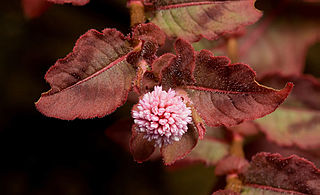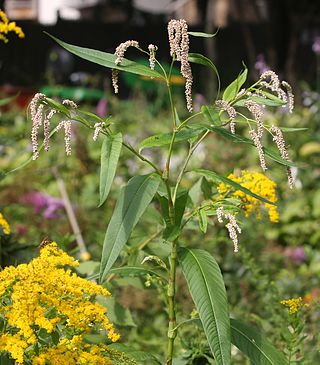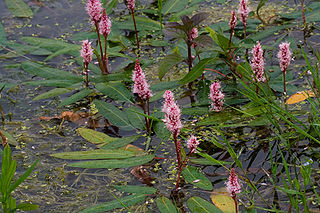
The Polygonaceae are a family of flowering plants known informally as the knotweed family or smartweed—buckwheat family in the United States. The name is based on the genus Polygonum, and was first used by Antoine Laurent de Jussieu in 1789 in his book, Genera Plantarum. The name may refer to the many swollen nodes the stems of some species have, being derived from Greek [poly meaning 'many' and gony meaning 'knee' or 'joint']. Alternatively, it may have a different origin, meaning 'many seeds'.

Persicaria is a genus of herbaceous flowering plants in the knotweed family, Polygonaceae. Plants of the genus are known commonly as knotweeds or smartweeds. It has a cosmopolitan distribution, with species occurring nearly worldwide. The genus was segregated from Polygonum.

Polygonum is a genus of about 130 species of flowering plants in the buckwheat and knotweed family Polygonaceae. Common names include knotweed and knotgrass. In the Middle English glossary of herbs Alphita, it was known as ars-smerte. There have been various opinions about how broadly the genus should be defined. For example, buckwheat has sometimes been included in the genus as Polygonum fagopyrum. Former genera such as Polygonella have been subsumed into Polygonum; other genera have been split off.

Persicaria maculosa is an annual plant in the buckwheat family, Polygonaceae. Common names include lady's thumb, spotted lady's thumb, Jesusplant, and redshank. It is widespread across Eurasia from Iceland south to Portugal and east to Japan. It is also present as an introduced and invasive species in North America, where it was first noted in the Great Lakes region in 1843 and has now spread through most of the continent.

Hypochaeris radicata – also known as catsear, flatweed, cat's-ear, hairy cat's ear, or false dandelion – is a perennial, low-lying edible herb often found in lawns. The plant is native to Europe, but has also been introduced to the Americas, Japan, Australia, and New Zealand, where it can be an invasive weed. It is listed as a noxious weed in the northwestern U.S. state of Washington.

Persicaria pensylvanica is a species of flowering plant in the buckwheat family, Polygonaceae. It is native to parts of North America, where it is widespread in Canada and the United States. It has also been noted as an introduced species in parts of Europe and South America. Common names include Pennsylvania smartweed and pinkweed.

Persicaria lapathifolia, known as pale persicaria, is a plant of the family Polygonaceae. It is considered to be native throughout most of the world, from arctic to tropical realms, except South America and Southern Africa. It is closely related to Persicaria maculosa and as such is considered a weed in Britain and Europe. Other common names for the plant include pale smartweed, curlytop knotweed, and willow weed. It is a species complex made up of a great many varying forms, sometimes considered varieties. The environment also has a strong influence on the morphology of an individual plant.

Sonchus asper, the prickly sow-thistle, rough milk thistle, spiny sowthistle, sharp-fringed sow thistle, or spiny-leaved sow thistle, is a widespread flowering plant in the tribe Cichorieae within the family Asteraceae.

Persicaria virginiana, also called jumpseed, Virginia knotweed or woodland knotweed is a North American species of smartweed within the buckwheat family. It is unusual as a shade-tolerant member of a mostly sun-loving genus. Jumpseed is a perennial, named for its seeds which can "jump" several feet when a ripe seedpod is disturbed.

Daucus pusillus is a species of wild carrot known by the common names American wild carrot and rattle-snake-weed. Its Latin name means "little carrot", or "tiny carrot". It is similar in appearance to other species and subspecies of wild carrot, with umbels of white or pinkish flowers. The taproots are small, edible carrots. It should not be confused with Conium maculatum, which is highly poisonous.

Cardionema ramosissimum is a perennial plant in the family Caryophyllaceae, commonly known as sandcarpet, sandmat or tread lightly. It is a small, clumping, mat-forming plant found in a number of diverse habitats throughout its range, from sandy beaches and dunes to the high elevations of the Andes mountains. Cardionema ramosissimum has a disjunct distribution throughout the Americas, and is found on the Pacific coast of North America from Puget Sound to Baja California, in central Mexico, and widely across South America, from the Andes in Colombia to most of Argentina.

Bidens laevis is a species of flowering plant in the daisy family known by the common names larger bur-marigold and smooth beggarticks. It is native to South America, Mexico, and the southern and eastern United States. It grows in wetlands, including estuaries and riverbanks.

Persicaria chinensis, commonly known as creeping smartweed or Chinese knotweed, is a plant species from the family Polygonaceae. It is widespread across China, Japan, the Indian Subcontinent, Indonesia, Malaysia, and Vietnam. It is a common plant in Malaysia and Vietnam, where it is used in herbal remedies, such as for the treatment of dysentery, enteritis, and sore throat. It is a weed in some coastal areas of New South Wales and Queensland in Australia.

Persicaria amphibia is a species of flowering plant in the knotweed family known by several common names, including longroot smartweed, water knotweed, water smartweed, and amphibious bistort. It is native to much of North America, Asia, Europe, and parts of Africa, and it grows elsewhere as an introduced species and sometimes a noxious weed.

Persicaria punctata is a species of flowering plant in the knotweed family known by the common names dotted smartweed and dotted knotweed.

Morus celtidifolia, the Texas mulberry, is a plant species native to South America, Central America, Mexico, and the southwestern United States, ranging from Argentina north as far as Arizona and Oklahoma. In the US, it grows in canyons and on slopes, usually near streams, from 200–2,200 metres in elevation. It is very often referred to as "Morus microphylla," including in Flora of North America, but recent studies suggest that these names are synonymous with M. celtidifolia holding priority.

Ionopsis utricularioides, the delicate violet orchid, is an epiphytic orchid native to the warmer parts of the Americas. It is reported from Florida, Mexico, Central America, much of the West Indies including the Cayman Islands, South America as far south as Paraguay, and the Galápagos.
Brickellia diffusa is a Latin American species of flowering plants in the family Asteraceae. It is widespread across much of South America, Central America, Mexico, Galápagos, and the West Indies. Its distribution stretches from Sonora and Tamaulipas in northern Mexico to Jujuy in northern Argentina.

Flaveria bidentis, the coastal plain yellowtops, is a South American plant species of Flaveria within the family Asteraceae. It is native to South America, and naturalized in many places.

Daniel Atha is an American botanist. In his work as a botanist he has collected plants in all 50 states of the United States, as well as several additional countries. Atha's work was focused on three areas: "floristics—what plants grow in a particular region; taxonomy—how to tell one plant from another, what to call it and what it's related to; and applied botany—how plants are used for food, medicine, shelter and other useful purposes." Atha has been known as a prominent regional botanist, and the high-profile botanical projects with which he has been involved have garnered national and international attention.



















